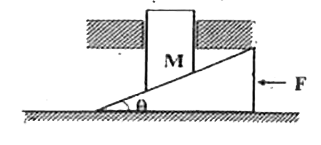What is the power required to push the woodn wedge horizontally with constant speed to raise the heavy block M, as shown in the figure. All surfaces are frictionless.

Since the wedge moves with uniform velocity, therefore, it is in equilibrium
and
thus,
The required power is

Topper's Solved these Questions
- WORK, ENERGY AND POWER BOOK - FIITJEECHAPTER - WORK, ENERGY AND POWER EXERCISE - SOLVED PROBLEMS ( OBJECTIVE)
18 Videos
- WORK, ENERGY AND POWER BOOK - FIITJEECHAPTER - WORK, ENERGY AND POWER EXERCISE - SOLVED PROBLEMS ( OBJECTIVE) ASSERTION REASONING TYPE
1 Videos
- WORK, ENERGY AND POWER BOOK - FIITJEECHAPTER - WORK, ENERGY AND POWER EXERCISE - COMPREHENSIONS ( Comprehension-II)
5 Videos
- TEST PAPERSBOOK - FIITJEECHAPTER - TEST PAPERSEXERCISE - PHYSICS
747 Videos
Similar Questions
Find the acceleration of the block of mass M in the situation shown in figure. All the surfaces are frictionless.

View SolutionA small block of mass m=2kg is at rest point P of the stationary wedge having frictionless hemispherical track of radius R=4m. The minimum constant acceleration 'a0' ( in m/s2) is to be given to the wedge in horizontal direction, so that the small block just reaches the point Q as shown in figure. Assume all the contacts are frictionless and g=10m/s2. If a0=2xm/s2. Find the value of x

View Solution
Knowledge Check
Assuming all the surfaces to be frictionless accelration of the block c shown in the figure is
 A5m/s2B7m/s2C3.5m/s2D4m/s2
A5m/s2B7m/s2C3.5m/s2D4m/s2
For what value of F will the block of mass m remains at rest with respect to the wedge. All surfaces are frictionless.

View SolutionA wedge of mass M lies on a smooth fixed wedge of inclination θ. A particle of mass m lies on the wedge of mass M in the figure. All surfaces are frictionless and the distance of the block from the fixed wedge is l. Find.

(a) Normal reaction between m and M
(b) the time after which the particle will hit the fixed plane.
View SolutionFigure shows a small block of mass m which is started with a speed v on the horizontal part of the bigger block of mas m placed on a horizontal floor. The curved part of the surface shown is semicircular. All the surfaces are frictionless. Find the speed of the bigger block when the smaller block reaches the point A of the surface.

View SolutionFor the figure shown, block of mass m is released from the rest. Find the distance of the wedge from initial position, when block m arrives at the bottom of the wedge. All surfaces are frictionless.
View SolutionA block of mass m is placed on the inclined sufrace of a wedge as shown in fig. Calculate the acceleration of the wedge and the block when the block is released. Assume all surfaces are frictionless.

View SolutionA block of mass m rests on a wedge of mass M which, in trun, rests on a horizontal table, as shown in figure. All surfaces are frictionless. If the system starts at rest with point P of the block a distance h above the table, find the speed of the wedge the instant point P touches the table.

View Solutionfind the acceleration of the block of mass M in the situation shown in figure. All the surfaces are frictionless and the pulleys and the string are light.

View Solution
